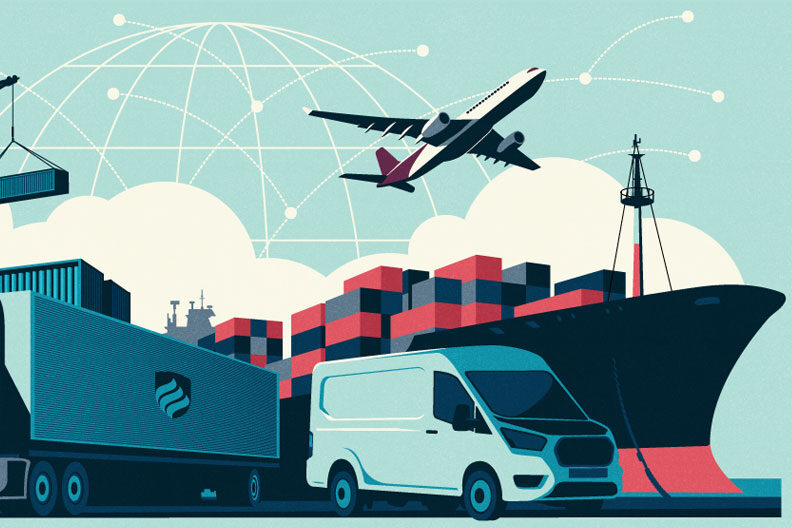Supply Chain Sourcing and Buying 101
GRADUATE STUDIES | 5 MIN READ

There’s a lot more to buying than just doling out money. Supply chain sourcing and buying professionals don’t just buy whatever goods and services are available to them. They build strategic partnerships and leverage the supply chain to extract value and create a competitive advantage.
At its core, sourcing is about finding high-quality, low-cost goods, but a lot of thought goes into that process. Those who source and buy continually weigh options in hopes of getting the most bang for the business’ buck.
For example, do you spend a little more to get something a little better and cut into profits? Or spend less and risk disappointing your customers and potentially losing sales?
Done right, supply chain sourcing and buying can give any business a winning edge. It just takes skilled people to make that happen. Here are some of the basic considerations they make while on the job.
Buying Basics
Finding the right balance between choice materials and affordability is an evolving, ongoing endeavor. Deciding how much value to place on those criteria—cost vs. quality—takes time, effort and experience in the field of supply chain management.
The first order of business is establishing standards for what your company wants. Supply chain buyers work to answer the following questions:
- To what extent does the product need to hold up over time?
- Are you making a repeat order, or is it a one-time buy? Will you maintain a relationship with the supplier over time?
- What kind of time constraints are you under? How much lead time do you need for your order?
- What are the ethical or moral considerations, such as environmental impact or work conditions for laborers?
Many other factors come into play, of course. But this will get you started as you pinpoint the goods and services that will complement your company’s business model.
Next, you’ll scout for suppliers that can deliver the goods. Identifying them is usually not hard. Vetting them can be more difficult.
Choosing a Supplier
To find the most suitable supplier, you’ll move beyond the basics of buying into the more advanced aspects of strategic sourcing.
Before choosing a supplier, consider the following:
- Risk. Any risk in the supply chain can put your products, business and brand in jeopardy. Careful risk management, and an understanding of your legal options, can mitigate it.
- Finances. You can price shop till you drop, but what’s the optimal amount you want to pay? Here is where knowing how to calculate the “should” cost of a material or service pays off.
- Performance. Before agreeing to anything, you’ll set key performance indicators, or KPIs, that suppliers must meet in order to win a contract with your business. You’ll evaluate KPIs throughout the relationship to make sure suppliers are holding up their end of the bargain.
At the same time, you’ll also want to keep tabs on the overall business landscape. What are your competitors doing? Are any potential upstarts disrupting the marketplace? Are the suppliers with the best reputations still delivering the best performance? Do suppliers with less-than-stellar reputations pose a public-relations risk?
If this seems like a lot, know that a properly educated sourcing professional can stay on top of it all—and more.
Which brings us to the “more”: Negotiating with the supplier(s) you select. It’s tempting to think in terms of winning and losing here, but strategic sourcing pros keep the bigger picture in mind. They use advanced negotiation tactics that lead to win-win solutions for the buyer and seller.
Time to Purchase
Once you’re ready to buy, you’ll be switching from negotiations to logistics: juggling purchase orders and shipment notices, managing inventory, and handling storage. Spreadsheets will become your best friends as you track and compare vendor information and evaluate the cost and quality of the products you are receiving.
That documentation is invaluable because there is no such thing as permanence in supply chain sourcing and buying. Even if a supplier checks all the boxes, you have to have a backup—and maybe a backup for the backup.
Suppliers move, go out of business, raise their prices, lose their edge. Your needs might also change.
For these and many other reasons, you’ll start back at square one more often than you think. All the more important to have a sound strategy. It will give you a firm idea of when to walk away from a supplier, or, if the supplier drops out, where to go next.
It’s unlikely you’ll ever lock down a source that meets every one of your business needs, but if you create sustainable relationships and are proactive to prevent failures, you’ll be well ahead of the game.
After all, a strong supply chain relies on the quality and cost-effectiveness of its sourcing and buying links.
M.S. in Supply Chain Management
The real key to understanding supply chain sourcing and buying is to learn from people doing it. When you enroll in the Supply Chain Management master’s program at Elmhurst University, you will join a cohort that meets on campus one evening a week with faculty members who are experts in their field. You’ll increase your aptitude for today’s—and tomorrow’s—business environment by taking a deep dive into sourcing and purchasing, logistics, negotiation, strategic planning, IT, e-commerce and customer relations.
In addition, you will make connections in the field and gain hands-on experience. You and your classmates will join a built-in network of Elmhurst alumni and professors who can connect you to employers in the Chicago area and across the United States.
Find out more by requesting information today!


